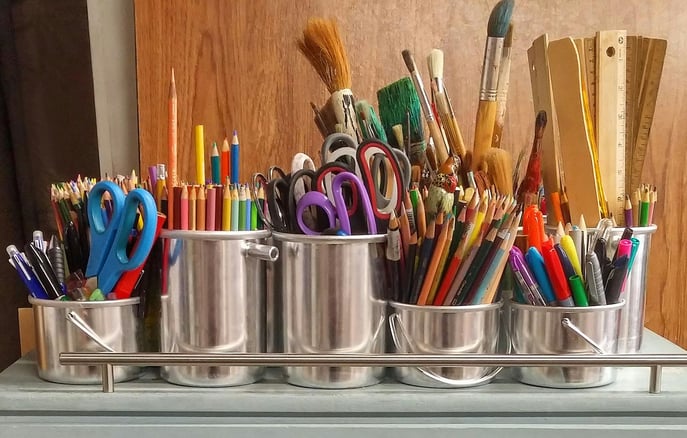The Ultimate Guide to Choosing the Right Art Supplies for Beginners
This is a comprehensive resource designed to help new artists navigate the vast world of art materials. This guide breaks down essential tools for various mediums, offering practical tips on selecting quality supplies that fit any budget. Perfect for those just starting their creative journey, it ensures a smooth and informed entry into the world of art.
10/16/20243 min read


Starting your art journey can be exciting but also overwhelming, especially when faced with the multitude of art supplies available. Whether you're interested in painting, drawing, or other creative endeavors, choosing the right tools is essential for a smooth and enjoyable experience. This guide will help you understand the basic supplies needed for beginners and how to pick the best ones without breaking the bank.
1. Understanding the Basics: What Do You Need?
Before diving into shopping, it's important to know which type of art you want to focus on. Are you interested in drawing, painting, or maybe experimenting with mixed media? Each discipline requires its own set of tools.
Key Categories of Art Supplies:
Drawing: Pencils, erasers, sketchbooks, and markers
Painting: Brushes, paints, canvases, and palettes
Mixed Media: A combination of tools from different mediums like paint and collage materials
2. Drawing Essentials
For beginners, drawing is often the easiest and most accessible way to start. The main supplies you’ll need are:
Pencils: Start with a range of pencil grades, such as HB, 2B, and 4B. These will allow you to experiment with shading and line quality.
Sketchbooks: Choose a good-quality sketchbook with thick paper. For beginners, a medium-sized one (around 9x12 inches) is usually sufficient.
Erasers: A kneaded eraser is great for gently removing graphite without damaging the paper.
Sharpener: A basic hand sharpener works well, but a good-quality metal one will last longer.
3. Painting Essentials
If you’re leaning toward painting, your supplies will vary depending on the medium (acrylics, watercolors, or oils). Acrylic is often recommended for beginners due to its versatility and ease of use. Here's what you'll need:
Acrylic Paints: Choose a beginner’s set that includes primary colors (red, blue, yellow) plus black and white. This will allow you to mix a variety of hues.
Brushes: A set of synthetic brushes in varying sizes, including flat and round tips, will give you a good starting point.
Canvas or Paper: You can start with canvas boards or thick acrylic paper to practice. These are more affordable than stretched canvases but still provide a good surface for painting.
Palette: A plastic or disposable palette will allow you to mix colors easily.
4. Colored Pencils and Markers
If you prefer something in between painting and drawing, colored pencils and markers are a great option. They’re easy to work with and provide vibrant results.
Colored Pencils: Go for a beginner-friendly set of 12 or 24 colors. Brands like Prismacolor offer soft-core pencils that blend beautifully, perfect for shading and layering.
Markers: Alcohol-based markers, such as Copic or Winsor & Newton, offer smooth blending and bright colors. However, they can be expensive, so start with a small set or even water-based markers for practice.
5. Budget-Friendly Options
Art supplies can add up quickly, so it's important to find quality items that fit your budget. Here's how to do that:
Start Small: You don’t need every color or every brush size right away. Start with a few basics and build your collection over time.
Student-Grade Materials: These are often more affordable than professional-grade supplies, and they’re perfectly suitable for beginners.
Look for Deals: Many art supply stores offer discounts and sales, especially online. You can also check for beginner kits that bundle several supplies at a discounted rate.
6. Caring for Your Art Supplies
Investing in art supplies means taking care of them to ensure they last. Proper care can extend the life of your tools:
Brushes: Always clean brushes thoroughly after each use, especially when using acrylics, as they can harden quickly.
Pencils and Markers: Store your pencils in a case and keep markers capped tightly to prevent drying out.
Paints: Store paints in a cool, dry place, and make sure lids are sealed to avoid drying out.
7. Experiment and Have Fun!
While it’s important to have the right tools, don’t let yourself get bogged down in finding the “perfect” supplies. The best way to learn and improve your art skills is through experimentation. Try different materials, explore various techniques, and most importantly, have fun!
Final Thoughts
Choosing the right art supplies as a beginner doesn’t have to be daunting. By starting with the essentials and gradually building your collection, you’ll have everything you need to embark on your creative journey. With practice and patience, your skills will grow, and so will your understanding of what tools work best for you. Happy creating!
Creativity
Explore art, learn, and embrace your passion.
CONTACT US:
Expression
artandanomaly@gmail.com
© 2024. All rights reserved.
